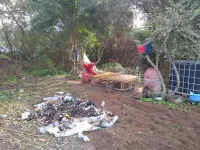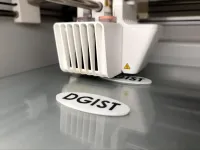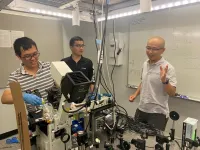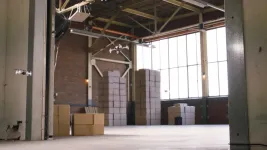INFORMATION:
The CAS Microbiome Initiative, the National Natural Science Foundation of China, U.S. National Institutes of Health, U.S. National Science Foundation and the Alfred P. Sloan Foundation supported this work.
Seven degrees from one trillion species of microbes
Global Microbiome Transition Network hints at origins and evolution paths of microbiomes
2021-07-14
(Press-News.org) The Earth contains about one trillion species of microbes -- only about one-tenth of which have been identified. A single human can house 100 trillion microbes, creating a single microbiome that serves an ecosystem of microbes.
Microbes connect and transform in myriad ways, creating and combining and separating microbiomes anew. How can we begin to parse out how microbiomes differ, how they are similar, how they evolved and how they may change in the future?
An international team of researchers may have the answer. They published a scale-free, fully connected search-based network to explore the connectedness of microbiomes across the world on July 13 in mSystems.
"The microbiome composition, a fundamental feature of all microbiota -- microbes sharing a particular characteristic such as site or geological period -- is shaped by a plethora of environmental factors," said co-first author JING Gongchao, a researcher in the Single-Cell Center in Qingdao Institute of BioEnergy and Bioprocess Technology (QIBEBT) of the Chinese Academy of Sciences (CAS). "However, it remains unclear whether and how compositional changes at the 'community-to-community' level among microbiomes are linked to the origin and evolution of global microbiome diversity."
To better understand how the vast number of varying microbe species evolved, JING and ZHANG Yufeng, a graduate student from Qingdao University, built a global "microbiome transition network" (MTN) that connects, based on their composition similarities, 177,022 microbiomes from 20 diverse ecosystems that include the plethora of ecological niches on human body and in the environment.
They used the Microbiome Search Engine (MSE; http://mse.ac.cn), a software developed by the team. MSE can construct the global transition network of microbiomes under three hours, and return the closest neighbors of a query microbiome in less than 0.5 second.
Interestingly, the global MTN is scale-free, which is similar to the Internet or the social network among human individuals. In this kind of networks, most nodes are each connected to a small number of other nodes, yet a small portion of nodes are connected to many other nodes. Such network structure ensures a strong degree of tolerance of the network against accidental perturbation.
"We drew the first global microbiome transition roadmap to illustrate the potential yet most likely paths to explain the evolution process of global microbiomes," explained SU Xiaoquan, a professor at Qingdao University and one senior author of the study, noting that the roadmap traces high similarities between microbiomes. "Although the compositions are distinct by habitat, each microbiome is, on average, only six "relatives" (or seven "steps") from any other microbiome on Earth, indicating the inherent homology and common origin of the microbiomes at the global scale."
On the other hand, information from the global MTN can indicate important information, such as evolvement or interaction of microbiomes. For example, the roadmap revealed that, the oceans are the most likely microbiomes that interact with beach sands and marine fishes, while soil and fresh water are the gateway of microbial exchange between the environment and plants or humans.
With the rapid change in climate as well as civilization on Earth, numerous microbiomes are disappearing, and emerging, every day. Although only a tiny proportion of them were recorded via metagenome sequencing, to construct and update the global MTN can be a "mission impossible", without powerful search engines and standardized databases for microbiomes such as those in MSE.
"Such search-based global microbiome networks, reconstructed within hours on just one computing mode via MSE, provide a readily expanded reference for tracing the origin and evolution of existing microbiomes, and perhaps for guiding the design of new microbiomes" said XU Jian, Director of Single-Cell Center at QIBEBT and the other senior author of the study.
ELSE PRESS RELEASES FROM THIS DATE:
Virtual care: Choosing the right tool, at the right time
2021-07-14
Kumara Raja Sundar, MD, a family physician at Kaiser Permanente of Washington, uses two media synchronicity theory principles - conveyance and convergence - as a framework for choosing the right medium of care for his patients. In this essay, Sundar discusses how operating within this framework changed his own practice and decision making during the COVID-19 pandemic, particularly with the use of telemedicine versus in-person clinic visits. The theory of conveyance focuses on transmitting and processing diverse information to understand a situation. It requires time to analyze data, create patterns and make conclusions. Convergence focuses on discussing pre-processed information to achieve a mutual understanding of it. ...
Drug combination shows meaningful responses for malignant peritoneal mesothelioma patient
2021-07-14
HOUSTON - A phase II study led by researchers from The University of Texas MD Anderson Cancer Center found that treatment with atezolizumab and bevacizumab was well-tolerated and resulted in a 40% objective response rate in patients with advanced malignant peritoneal mesothelioma, a rare cancer in the lining of the abdomen. Responses occurred in patients regardless of PD-L1 expression status and tumor mutation burden.
Trial results indicated that the combination was safe and effective in patients with disease progression or intolerance to previous chemotherapy ...
Experts tackle modern slavery in Greek strawberry fields using satellite technology
2021-07-14
A consortium of modern slavery experts, led by the University of Nottingham, have assisted the Greek government to tackle a humanitarian crisis unfolding in the strawberry fields of southern Greece.
Using satellite technology to identify migrant settlements - a technique pioneered by the university's Rights Lab - and working with the Greek authorities, the experts then developed a decision model for which they could prioritise victims that were at highest risk.
Leading the study, the Rights Lab combined different data sources and methods to build a set of criteria measuring the extent of labour exploitation in a settlement. The academics then validated these criteria with a government agency and a Non-Governmental ...
Solar radio signals could be used to monitor melting ice sheets
2021-07-14
The sun provides a daunting source of electromagnetic disarray - chaotic, random energy emitted by the massive ball of gas arrives to Earth in a wide spectrum of radio frequencies. But in that randomness, Stanford researchers have discovered the makings of a powerful tool for monitoring ice and polar changes on Earth and across the solar system.
In a new study, a team of glaciologists and electrical engineers show how radio signals naturally emitted by the sun can be turned into a passive radar system for measuring the depth of ice sheets and successfully tested it on a glacier in Greenland. The technique, ...
Lean and mean: Building a multifunctional pressure sensor with 3D printing technology
2021-07-14
The treatment of many medical issues like abnormal gait and muscular disorders require an accurate sensing of applied pressure. In this regard, flexible pressure sensors that are simple, lightweight, and low-cost, have garnered considerable attention. These sensors are designed and manufactured through "additive manufacturing," or what is more commonly called "3D printing," using conductive polymer composites as their building blocks.
However, all 3D-printed pressure sensors developed so far are limited to sensing applied forces along a single direction only. This is hardly enough for real ...
Study: Idea sharing increases online learner engagement
2021-07-14
CHAMPAIGN, Ill. -- Sharing ideas in an online learning environment has a distinct advantage over sharing personal details in driving learner engagement in massive open online courses, more commonly known as MOOCs, says new research co-written by a University of Illinois Urbana-Champaign expert who studies the intersection of marketing and digital environments.
Online learning engagement can be increased by nearly one-third by simply prompting students to share course ideas in a discussion forum rather than having them share information about their identity or personal motivations for enrolling, said Unnati Narang, a professor of business administration at the Gies College ...
Chemistry discovery could remove micropollutants from environment
2021-07-14
RESEARCH TRIANGLE PARK, N.C. -- Army-funded research identified a new chemistry approach that could remove micropollutants from the environment.
Micropollutants are biological or chemical contaminants that make their way into ground and surface waters in trace quantities.
Using a pioneering imaging technique, Cornell University researchers obtained a high-resolution snapshot of how ligands, molecules that bind to other molecules or metals, interact with the surface of nanoparticles. In doing so, they made an unexpected breakthrough discovery. They determined that by varying the concentration of an individual ligand they could control the shape of the particle it attached too.
This approach could ...
Swarm of autonomous tiny drones can localize gas leaks
2021-07-14
When there is a gas leak in a large building or at an industrial site, human firefighters currently need to go in with gas sensing instruments. Finding the gas leak may take considerable time, while they are risking their lives. Researchers from TU Delft (the Netherlands), University of Barcelona, and Harvard University have now developed the first swarm of tiny - and hence very safe - drones that can autonomously detect and localize gas sources in cluttered indoor environments.
The main challenge the researchers needed to solve was to design the Artificial Intelligence for this complex task that would fit in the tight computational and memory constraints of the tiny drones. They solved this challenge by means of bio-inspired navigation and search strategies. The scientific ...
Study highlights need to replace 'ancestry' in forensics with something more accurate
2021-07-14
A new study finds forensics researchers use terms related to ancestry and race in inconsistent ways, and calls for the discipline to adopt a new approach to better account for both the fluidity of populations and how historical events have shaped our skeletal characteristics.
"Forensic anthropology is a science, and we need to use terms consistently," says Ann Ross, corresponding author of the study and a professor of biological sciences at North Carolina State University. "Our study both highlights our discipline's challenges in discussing issues ...
Sweet spot for membrane thickness offers sustainable separations
2021-07-14
Super-thin carbon molecular sieve (CMS) membranes may not be best for separating industrially important chemical mixtures. However, ensuring the CMS film thickness is just right could enable more energy-efficient purification of chemical products, KAUST researchers have shown.
CMS membranes, as their name suggests, can purify mixtures of liquids or gases by permitting only certain molecules to pass through their subnanometer-sized pores. Currently, the chemical industry mainly uses heat-based processes such as distillation to separate product mixtures, but these processes consume about 10 percent of global energy output. "This situation is highly unsustainable," says Wojciech Ogieglo, a research scientist at KAUST. "We believe that a good ...
LAST 30 PRESS RELEASES:
World-first discovery uncovers how glioblastoma tumours dodge chemotherapy, potentially opening the door to new treatments
A fatal mix-up: How certain gut bacteria drive multiple sclerosis
New AI tool identifies not just genetic mutations, but the diseases they may cause
Deep-learning model predicts how fruit flies form, cell by cell
Combination pills for high blood pressure may simplify treatment, improve long-term health
Immune system keeps mucosal fungi in check
Neurons within the brain use simple rules to localize genetic messages
Electrodes created using light
Second-hand gift-giving is a well-deliberated decision
How human interaction drove evolution to make bears less aggressive
National Poll: Few parents offer teens guidance on healthy eating during holiday season
Cannabis derivatives could provide new ovarian cancer treatments
Raising strong yeast as a petroleum substitute
Clues to the origin of hot Jupiters hidden in their orbits
Canada’s reduced pledge to Global Fund will impact domestic health
1 in 4 children with major traumatic injuries not cared for in pediatric trauma centres
Duke and Duke-NUS’ joint cross-population research to uncover "East-West" differences in disease and care
Scientists to ‘spy’ on cancer- immune cell interactions using quantum technology breakthrough
Tech savvy users have most digital concerns
Making lighter work of calculating fluid and heat flow
Normalizing blood sugar can halve heart attack risk
Lowering blood sugar cuts heart attack risk in people with prediabetes
Study links genetic variants to risk of blinding eye disease in premature infants
Non-opioid ‘pain sponge’ therapy halts cartilage degeneration and relieves chronic pain
AI can pick up cultural values by mimicking how kids learn
China’s ecological redlines offer fast track to 30 x 30 global conservation goal
Invisible indoor threats: emerging household contaminants and their growing risks to human health
Adding antibody treatment to chemo boosts outcomes for children with rare cancer
Germline pathogenic variants among women without a history of breast cancer
Tanning beds triple melanoma risk, potentially causing broad DNA damage
[Press-News.org] Seven degrees from one trillion species of microbesGlobal Microbiome Transition Network hints at origins and evolution paths of microbiomes







